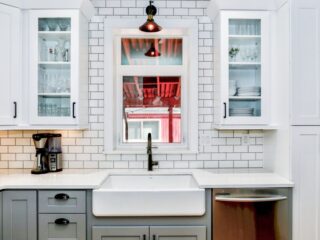
Creating a safe home environment is one of the most important responsibilities of parenting. With curious toddlers eager to explore, child-proofing your home isn’t just recommended—it’s necessary. This guide offers detailed, actionable advice to help you protect your child while fostering a safe and nurturing environment.
Why Child-Proofing Matters
Every home contains hidden dangers that aren’t obvious until you consider them from a child’s perspective. From sharp furniture edges to toxic cleaning supplies, potential risks are everywhere.
According to the CDC, more than 3 million children visit emergency rooms annually due to injuries sustained at home. Taking the time to address these risks can drastically reduce the likelihood of accidents.
The goal of child-proofing isn’t to restrict your child but to create a space where they can safely explore and grow. By following these steps, you can achieve a balance between safety and freedom.
Start with a Child’s Eye View
To understand potential hazards, you need to see your home from your child’s perspective. Crawling on the floor gives you a better view of low-level dangers like electrical outlets, sharp edges, and unsecured objects.
Actionable Tips:
- Inspect Reachable Areas: Look for dangling cords, small objects, or breakables within arm’s reach.
- List Hazards by Room: Create a checklist of risks in each room and tackle them systematically.
- Think Ahead: Anticipate what will be accessible as your child grows and becomes more mobile.
Example: Did you know that even loose change left on a coffee table can become a choking hazard for toddlers? Always tidy up surfaces at your child’s level.
Secure Furniture and Appliances
Furniture like bookshelves and TVs are among the leading causes of preventable home accidents.

A curious child climbing or pulling on these items can cause them to topple over, resulting in serious injuries.
How to Secure Your Furniture
- Anchor Heavy Furniture: Use wall brackets or straps to prevent furniture from tipping.
- Stabilize TVs: Place flat-screen TVs on low, secure stands or mount them on the wall.
- Prevent Climbing: Avoid placing enticing items like toys or remote controls on top of furniture, as this encourages climbing.
Pro Tip: Always test the stability of anchored furniture by giving it a gentle tug to ensure it’s securely fastened.
Store Chemicals Safely
Household chemicals, including cleaning agents, paints, and pesticides, pose significant risks if accessed by children. Proper storage is essential to prevent accidental poisoning, burns, or other serious injuries.
Safe Storage Practices
- Use Locked Cabinets: Store all chemicals in cabinets equipped with child-proof locks.
- Original Containers: Keep chemicals in their original containers with labels intact to avoid confusion or misuse.
- Secure High Storage: Place chemicals on high shelves or in out-of-reach areas, away from where children play.
- Invest in Professional Storage Solutions: For households with larger quantities of chemicals, consider using dedicated liquid chemical storage cabinets to ensure maximum safety and compliance with storage standards.
Additional Tip: Regularly check for leaks or damaged containers, as even a small spill can pose a hazard. Dispose of expired or unused chemicals promptly and safely according to local regulations.
Install Baby Gates
Stairs, kitchens, and certain rooms require restricted access for safety.

Baby gates are an essential tool to block off these high-risk areas.
Choosing the Right Gate
- Hardware-Mounted Gates: Ideal for stairs as they are more secure.
- Pressure-Mounted Gates: Great for doorways or areas without major safety risks.
Expert Advice: Avoid accordion-style gates with wide openings that could trap your child’s head or limbs. Always ensure gates are properly installed and cannot be easily pushed over.
Lock Hazardous Areas
Certain spaces in your home—like the kitchen, bathroom, and garage—contain items that pose significant risks. Locking these areas is a simple yet effective way to prevent accidents.
Steps to Secure Hazardous Zones
- Cabinet Locks: Install magnetic or latch-style locks on cabinets containing cleaning supplies, medications, or sharp tools.
- Appliance Locks: Use locks for ovens, refrigerators, and dishwashers to prevent access.
- Garage Safety: Store chemicals, tools, and equipment on high shelves or in locked cabinets.
Did You Know? Many cleaning products, even “green” ones, are toxic if ingested. Always keep these items out of sight and reach.
Protect Electrical Outlets
Electrical outlets are highly attractive to curious toddlers. Without proper precautions, they can cause electrical shocks or burns.
How to Child-Proof Outlets
- Outlet Covers: Use tamper-resistant outlet covers that snap securely in place.
- Slide Covers: Install outlets with built-in sliding covers that automatically close when not in use.
- Organize Cords: Bundle and secure loose electrical cords with cord shorteners or hide them behind furniture.
Safety Insight: Never leave phone chargers plugged in when not in use—toddlers may chew on the cords, risking burns or shocks.
Ensure Window Safety
Windows might seem harmless, but they can pose risks of falls and strangulation from blind cords. Securing windows is crucial, especially in multi-story homes.
How to Make Windows Safe
- Window Guards: Install sturdy window guards to prevent falls. Ensure they are removable in case of emergencies.
- Limit Openings: Use window stops to restrict openings to no more than four inches.
- Cord Safety: Use cordless blinds or tie up cords with a cleat, keeping them out of reach.
It also makes your home safe from the outside. Home security ensures you minimize the chances of intruders entering your home.
Eliminate Choking Hazards
Choking is a common concern for young children, as they explore by putting objects in their mouths. Small toys, coins, and food pieces can all be dangerous.
What to Do
- Toy Inspection: Regularly inspect toys for loose parts that could break off and become choking hazards.
- Safe Storage: Store small items, like batteries or buttons, in secured, out-of-reach containers.
- Cut Food Safely: Cut food into small, manageable pieces and avoid giving children hard candies or popcorn.
Pro Tip: A toilet paper roll is a handy tool for testing object size—anything that fits inside is too small to be safe for a toddler.
Safeguard the Kitchen
The kitchen is one of the busiest and most hazardous areas in any home. From sharp knives to hot stovetops, it requires thorough child-proofing.
Kitchen Safety Hacks
- Stove Knob Covers: Prevent little hands from accidentally turning on burners.
- Drawer Locks: Secure drawers containing knives, scissors, or utensils.
- Hot Zones: Keep hot beverages and cookware away from the edge of tables or countertops.
Create a Safe Bathing Environment
Bathrooms combine water, slippery surfaces, and sharp edges—making them a hotspot for accidents. Ensuring bathroom safety can prevent slips, falls, and scalds.
How to Child-Proof Your Bathroom
- Water Heater Temperature: Set the water heater to 120°F to avoid scalding.
- Anti-Slip Mats: Place mats in the tub and on the bathroom floor.
- Toilet Locks: Prevent drowning risks by keeping toilet lids closed and locked.
Quick Reminder: Always unplug appliances like hair dryers after use to eliminate risks of electrocution.





